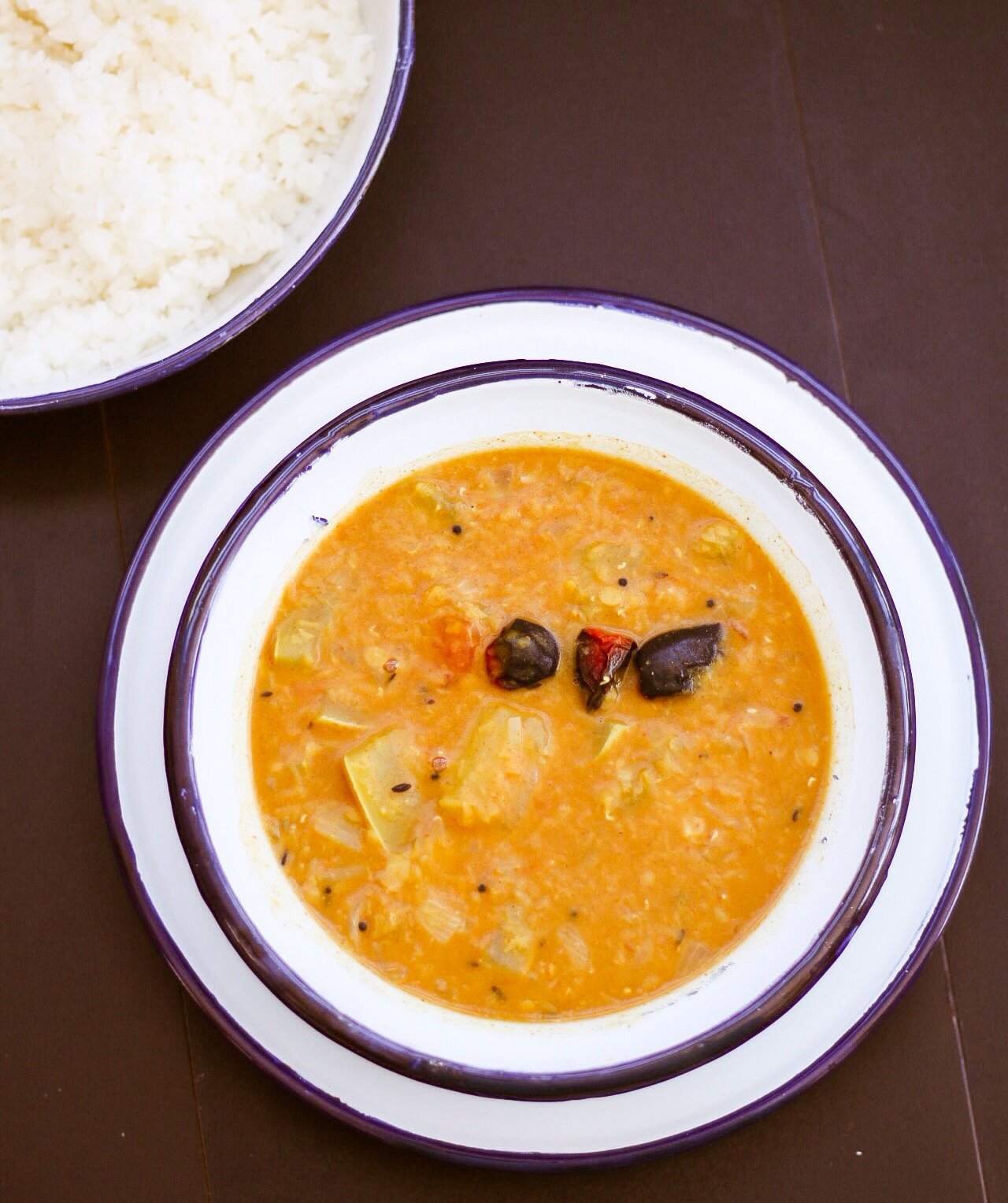Sorakkai Paruppu Kuzhambu is a delicious and super healthy South Indian curry where bottle gourd is cooked with lentils to make a tangy curry served with rice.


Sorakkai Paruppu Kuzhambu Recipe is a side dish recipe to prepare that can be done in about 20 minutes and hence is a great recipe for a busy weeknight dinner. Made with nutritious summer vegetable-bottle gourd, the curry is full of nutrients and is a coolant to the body as well.
Usually kuzhambu is a South Indian gravy that is made with tangy tamarinds or cooked along with coconut and other spices like sambar powder. Here I have used a tamarind base for the recipe to be tangy and addition if dal/pappu makes it creamy and hearty.
Once the dal gets pressure cooked, you need only some more time to saute the tadka with onions and cook with bottle gourd to prepare this recipe. Kuzhambu, in general- is a staple that is made in every Tamil household on a day-to-day basis.
Did you know: Bottle Gourd has 90% water in it. Bottle Gourd is recommended by Ayurveda for better digestion. Because of its water content, it’s a boon for weight watchers. It can help in quenching extreme thirst in diabetic patients. Loaded with essential minerals and vitamins like calcium, magnesium, phosphorus, Vitamin A, C and folate, it's popular for combating high blood pressure and improving heart health.
Serve Sorakkai Paruppu Kuzhambu Recipe along with Steamed Rice, Carrot and Beans Poriyal Recipe, Phulka and Kathirikai Pitlai Recipe to make it a complete meal.
Cuisine: Tamil Nadu
Course: Side Dish
Diet: Vegetarian
Equipments Used: Pressure Cooker , Shallow Frying Pan/ Skillet With Lid
Prep in
5 M
Cooks in
15 M
Total in
20 M
Makes:
4 Servings
Ingredients
- 1/2 Bottle gourd (lauki) , chopped
- 1/2 cup Yellow Moong Dal (Split), or masoor dal
- 1 Onion , chopped
- 1 Tomato , chopped
- 3 Dry red chillies
- 1/4 teaspoon Turmeric powder (Haldi)
- 1 tablespoon Sambar Powder
- 1/2 teaspoon Mustard seeds
- 1 teaspoon Cumin (Jeera) seeds
- Salt , to taste
- 1 teaspoon Cooking oil
- 1 teaspoon Ghee
How to make Sorakkai Paruppu Kuzhambu Recipe - Tamil Nadu Style Lauki Curry
- To begin making Sorakkai Paruppu Kuzhambu Recipe, wash and clean the bottle gourd, remove seeds, only if the seeds are too big and fibrous. Allow them to cook with bottle gourd if they are tender enough. Cut into small pieces. Chop onion and tomato alongside, as well.
- Wash dal and in a cooker, add dal and tomato with about 3 cups of water or enough to submerge the tomatoes.
- Close the lid and pressure cook for 2 whistles on high heat. Switch off and wait until the pressure seizes by itself.
- Heat a shallow frying pan with a bit of oil, add mustard seeds when the oil is hot,and allow to crackle. Keep the heat to low, so that tehta tadka does not get charred.
- Add cumin seeds immediately and allow them to sizzle. Add onions and red chillies. Saute until onions turn translucent.
- Once the pressure is released from the cooker, add the dal along with bottle gourd to the pan, or if you pan is smaller, add the contents of the pan to the pressure cooker and continue cooking.
- Add little required water and stir. Add salt, turmeric powder and sambar powder.
- Mix and allow it to boil on a medium flame until the bottle gourd is tender and cooked. Once everything is cooked to mashable consistency and looks well cooked, check for seasoning, adjust and then remove from heat. Add a teaspoon of ghee on top and keep it covered till served.
- Serve Sorakkai Paruppu Kuzhambu Recipe along with Steamed Rice, Carrot and Beans Poriyal Recipe, Phulka and Kathirikai Pitlai Recipe to make it a complete meal.
Sorakkai Paruppu Kuzhambu Recipe - Tamil Nadu Style Lauki Curry is part of the Beat The Heat With Summer Vegetables

No comments:
Post a Comment